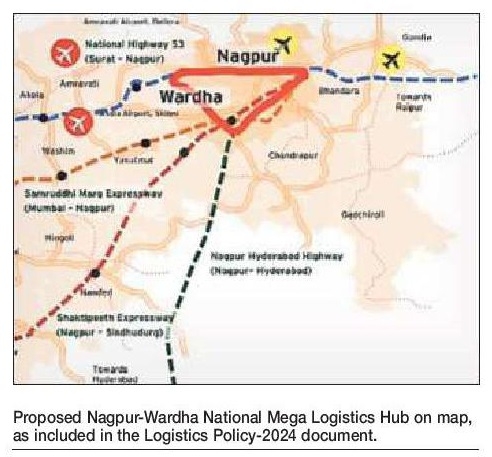Smart Logistics Zone proposed in Nagpur-Wardha National Mega Hub
| Date :01-Sep-2024 |

Staff Reporter :
Special incentives for Vidarbha and Marathwada regions with no premium for additional FSI
The new Logistics Policy-2024 unveiled by Maharashtra Government focusses on development of logistics sector in Vidarbha region. Under the policy, Nagpur-Wardha National Mega Logistics Hub is proposed. Under this national mega hub, a Smart Logistics Zone also is proposed.
Apart from the Nagpur-Wardha National Mega Logistics Hub, Vidarbha region will get nine District Logistics Nodes of minimum 100 acres in each district.
These nine districts include Buldhana, Akola, Washim, Yavatmal, Wardha, Bhandara, Gondia, Chandrapur, and Gadchiroli. Besides, a Regional Logistics Hub is proposed at Amravati-Badnera. It will be one of the five such regional hubs with 300 acres of land each.
Considering Nagpur’s significance as a major freight hub due to its geographical location, the Government has proposed Nagpur-Wardha National Mega Logistics Hub over an area of 1,500 acres to be identified in Nagpur and Wardha districts.
The land is to be identified specially for logistics infrastructure and ancillary areas with the help of local administration, and for development of Smart Logistics Zone through public-private partnership mode. The policy aims at significantly reducing the associated costs to make the concept of Smart Logistics Zone ‘truly accessible’ to entrepreneurs. But, the policy is silent on how this will be achieved.
Maharashtra Industrial Development Corporation (MIDC) shall be the special planning authority for the mega national hub, for acquisition of land and necessary approvals. The policy promises ‘special incentives’ to the first three anchor logistics entities that take lead in building ‘world-class logistics facilities’ by adopting Artificial Intelligence (AI), blockchain technology, motion sensors, and other emerging technologies. The AI will be used to facilitate and streamline logistics operations through
route optimisation, predictive maintenance and real-time decision-making capabilities.
The blockchain technology will ‘reduce inefficiencies’ by securing transparent and secure supply chain management, and provide seamless traceability capabilities, states the policy document. Motion sensor technology will play an important role in facilitating automated and efficient warehousing facilities.
The national hub will have several facilities including integrated multimodal logistics park, mega and ultra mega logistics parks, modular flexible warehouses, cold and dry storage, common facility centres, inland container depot, container freight stations, special incentives for green and smart logistics parks, additional incentives for use of AI-based technologies, truck/bus terminals and railway side-ins, connectivity to MIHAN, research and development and testing facilities, incubation centres, training facilities for skill development, hostel/dormitories and commercial zones, international exchange centres, etc.
For disbursement of incentives to the logistics sector, State has been classified into Zone 1, Zone 2, and Zone 3. Nineteen districts of industrially backward Vidarbha and Marathwada regions have been included in Zone-1. These include all 11 districts of Vidarbha.
As far as floor-to-space index (FSI) is concerned, one or permissible basic FSI, whichever is more, will be applicable to logistics parks. This FSI will be over the base FSI for development of all types of logistics parks. For entire Vidarbha and Marathwada regions, no premium will be charged for additional FSI under the new policy.